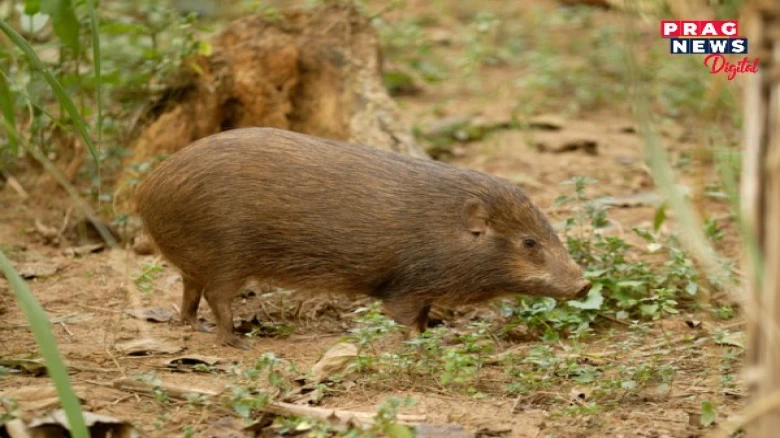National

The only population of pygmy hogs resides in Assam and is listed as Endangered on the IUCN Red List.
Digital Desk: We Join hands together to protect nature and wildlife, not just in India but worldwide.
Officials claimed the Pygmy Hog Conservation Programme (PHCP) had released 10 more captive-bred pygmy hogs in Manas National Park in western Assam in an active effort to conserve the creatures.
Pygmy hogs, the world's smallest and rarest wild pig, are being reintroduced in Manas for the third time after the successful release of 14 in 2020 and 12 in 2021. By 2025, the PHCP hopes to release 60 pygmy hogs in Manas.
Dr Vaibhav Chandra Mathur, Manas national Park's field director, stated that the pygmy hog species had been saved from extinction in the wild.
This replacement phase with a purebred population will improve wildlife conservation, especially for tall wet grasslands, for which the pygmy hog acts as an indicator species, he said, with the tiger reserve serving as the supply stock of hogs for the PHCP.
It's a chance, according to Mathur, to establish scientifically and statistically sound monitoring techniques for the species that may be implemented in the field regularly to keep a pulse on pygmy hog populations and dispersal conditions.
UK's Durrell Wildlife Conservation Trust of the UK partnered with the Assam Forest Department as well as the (IUCN) and the Wild Pig Specialist Group to form the PHCP in 1995.
According to Mathur, the renowned species is returning to its native habitat, where its final original population still exists but is rapidly dwindling.
The number of pygmy hogs returned into the wild by the PHCP now stands at 152 (70 males, 82 females), which is greater than their existing global wild population.
Six hogs (2 males and 4 females) were captured from Manas National Park's Bansbari region in 1996 to begin the highly successful breeding operation.
Later additions to the captive breeding population included a young male rescued in 2001 and another male and two females taken in 2013 from the same range. Finally, in 2008, caged hogs were released into the wild for the first time.
According to Mathur, the renowned species is returning to its native habitat, where its final original population still exists but is rapidly dwindling.
The number of pygmy hogs returned into the wild by the PHCP now stands at 152 (70 males, 82 females), which is greater than their existing global wild population.
Six hogs (2 males and 4 females) were captured from Manas National Park's Bansbari region in 1996 to begin the highly successful breeding operation.
Later additions to the captive breeding population included a young male rescued in 2001 and another male and two females taken in 2013 from the same range. Finally, in 2008, caged hogs were released into the wild for the first time.
Reportedly, Sonai-Rupai Wildlife Sanctuary released 35 hogs (18 males, 17 females), Orang National Park released 59 (26 males, 33 females), and Barnadi Wildlife Sanctuary released 22 (11 males, 11 females).
"Conservation of lesser-known species such as pygmy hogs, Bengal florican, and Hispid hare and other grassland obligatory species is equally important as that of charismatic species such as the tiger and the one-horned rhinoceros," said Dr. Bibhab Kumar Talukdar, chief executive officer of Aaranyak, a renowned NGO and a key partner of the PHCP.
The successful release of these 14 hogs in 2020 and 12 hogs in 2021 is a landmark achievement and is the key step on the road to the establishment of a new subpopulation of pygmy hogs in Manas National Park in the last two years when both coronavirus and African swine fever in Assam have posed major challenges for the PHCP.
On Bhutan's border, Manas National Park features some of the sub-Himalayan grassland ecosystems' largest intact grassland blocks.
"Durrell has been committed to saving the little but precious pygmy hog, and their grassland environment, for decades," said Dr. Lesley Dickie, who traveled to Assam to participate in this year's pygmy hog release.
Also Read: Manas National Park’s Tiger Team earns The International Rangers Award
Leave A Comment